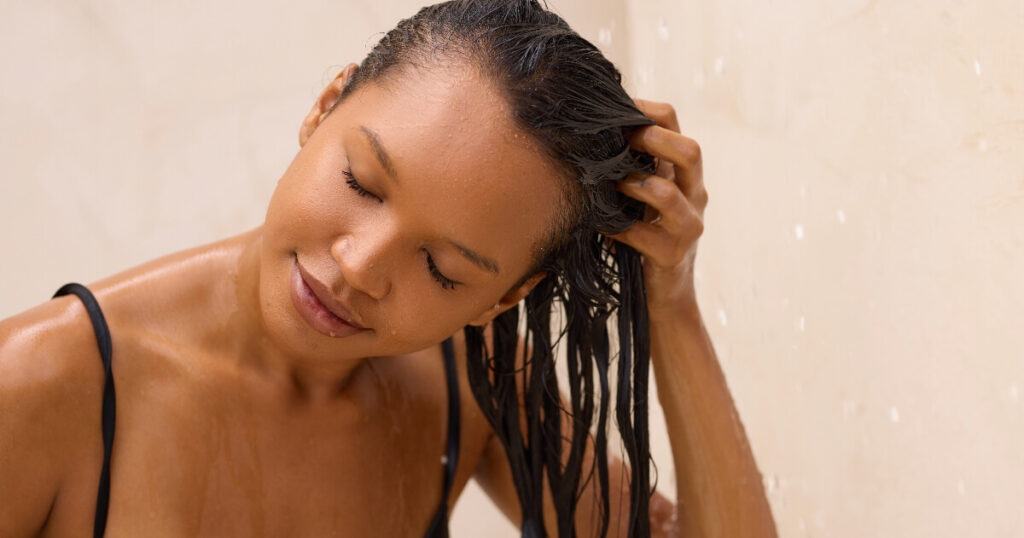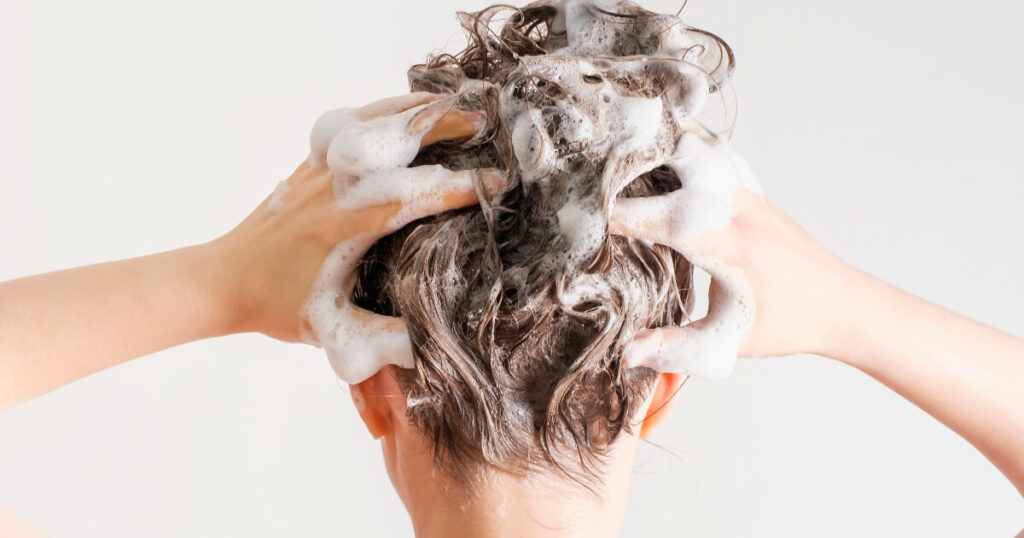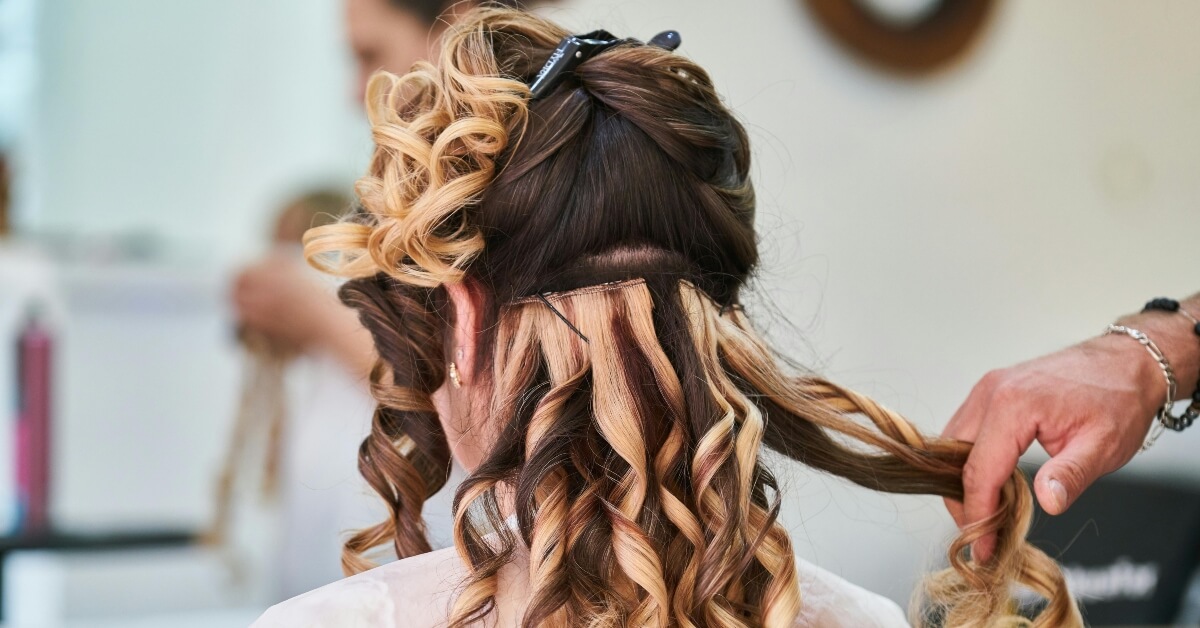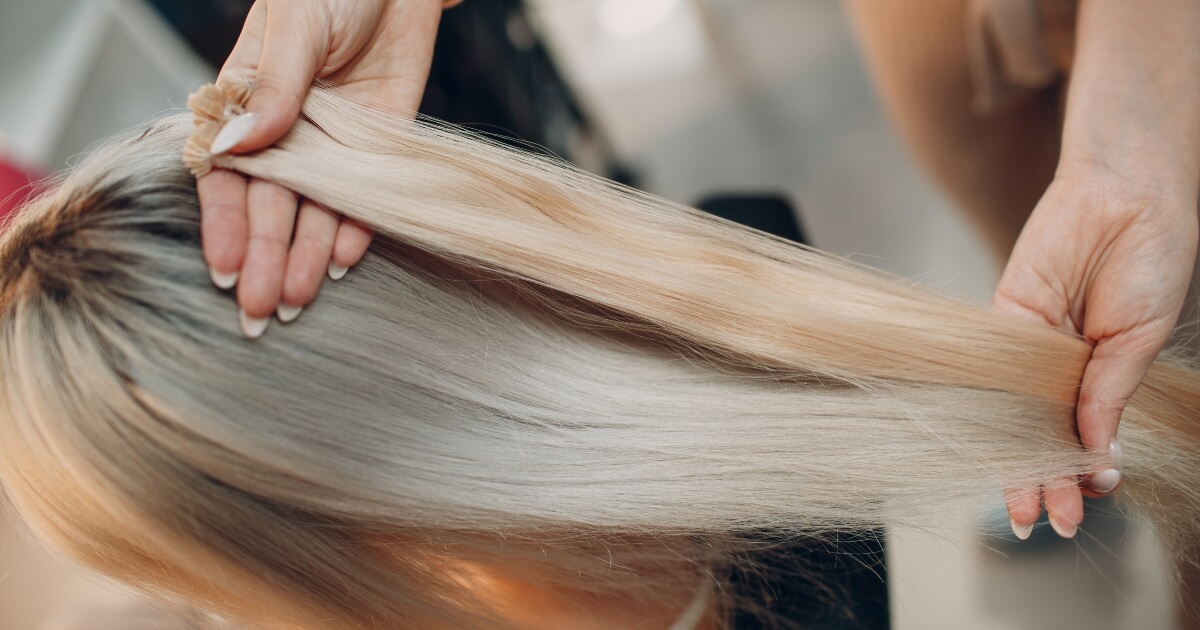Yes, clarifying shampoo will remove color from your hair. These products were specifically designed to remove substances that have built up in your hair, such as styling products, residue from hard water, pollutants in the environment and color.
People often use clarifying shampoo to give their hair a new start, or to prepare for a new hair color.
However, if you are not looking to start over with your hair, you need to be cautious with clarifying shampoo. Sure, there are many benefits to these shampoos, but you could unintentionally fade or even strip the dye from your hair.
This blog discusses clarifying shampoo in great detail, explaining how it works, the benefits, and most importantly, its effect on color-treated hair.
If you are looking to try a new color or repair color damage, book your appointment with Societe Salon. Our trusted stylists have delivered exceptional hair to thousands of clients. Our experienced team has an unwavering commitment to crafting amazing hair so our clients can achieve Beauty with Confidence.
10 Key Points From the Blog
- Use Caution on Color-Treated Hair
While clarifying shampoo can be helpful for buildup and oil, it can fade or color strip dyed hair in patches. It’s best used sparingly or under professional guidance. - It’s Great for Pre-Color Prep
Stylists use clarifying shampoo to remove buildup before applying color, helping the dye bond better with your hair. - Best for Fading Unwanted Color
If you want to fade fashion colors like pink, purple, or blue, clarifying shampoo—especially when combined with a plastic cap and warm water—can help speed up the process. - Deep Conditioning Is a Must
Clarifying shampoo can dry out your hair, so always follow up with a moisturizing conditioner or hair mask to restore hydration. - Clarifying Shampoo Doesn’t Fully Remove Permanent Dye
It may slightly fade permanent color through cuticle lifting and oxidation, but full color correction usually requires a professional treatment. - Dilution and Placement Can Help Preserve Color
Mix clarifying shampoo with regular shampoo, use it mostly on roots, and rinse with cold water to reduce color loss. - Hair Type Affects Fading Speed
Porous, damaged or recently dyed hair fades faster. Dark and well-set colors are much more resistant to clarifying shampoo. - There Are DIY Alternatives for Fading Color
Vitamin C tablets and baking soda with dandruff shampoo are common home remedies, but they also risk dryness and damage. - Societe Salon Offers Safer Alternatives
Whether you’re removing color, refreshing it, or transitioning to natural hair, Societe Salon’s experienced stylists can recommend the safest, most effective approach. - Clarifying Shampoo Can Reveal Natural Hair Color
By gradually fading artificial dye, clarifying shampoo helps expose your natural undertones. That is why it is a useful tool for those transitioning back to their original hair color or planning a future color refresh.

What is Clarifying Shampoo?
Clarifying shampoo is formulated to deep-cleanse your hair by removing substances/residues/impurities that have built up on the hair shaft, including excess sebum. Regular shampoo is not designed to strip these chemicals out of your hair.
Clarifying shampoos have much stronger ingredients (surfactants and chelating agents), including:
- Sodium lauryl sulfate
- Ammonium laurel sulfate
- EDTA
- Citric acid
These chemicals give clarifying shampoo higher alkalinity. This allows the shampoo to bind to minerals and metals, allowing water to wash them out of your hair. This helps to prevent you hair from looking greasy or dull.
While regular shampoos hydrate, clarifying shampoo’s main function is to cleanse your hair. Regular shampoo is meant for regular use, while clarifying shampoo is something you should only use infrequently.
Think of clarifying shampoo as a “reset button” for your hair. They strip away product buildup, hard water minerals, chlorine, and excess oils that can make your hair look dull.
Why Do People Use Clarifying Shampoo?
There are several reasons why people use clarifying shampoos on a regular basis. Clarifying shampoo:
Removes Product Buildup
Do you often use mousse, gel, hairspray or other styling products? They often create a residue that sticks to your hair even after numerous washes.
Treats Hair Washed With Hard Water
Do you live in an area that has hard water? For instance, do you get well water? This can leave mineral deposits in your hair.
Treating Your Hair Before Your Stylist Applies Color
Stylists often use clarifying shampoo before applying color. This helps ensure your hair cuticle is clean and ready to accept color.
Treats Swimmer’s Hair
Do you swim in swimming pools regularly? Chlorine in the water can damage and discolor your hair. Fortunately, clarifying shampoo can cleanse your hair, protecting it from damage and helping to return your hair to its natural state.
Managing An Oily Scalp
Some people have very oily scalps and clarifying shampoo can clean this oil out.
Despite these benefits, you should generally only use clarifying shampoo once a week at the most. Otherwise, you risk premature fading of color from your hair. Clarifying shampoo also strips oils from your hair, which can cause breakage.
What Does Clarifying Shampoo Do to Colored Hair?
The greatest strength of clarifying shampoo – its ability to deeply clean your hair – is also its greatest liability. The intense cleansing agents can open the hair cuticle and allow color molecules to escape. That means this shampoo could strip color from your hair or even cause it to fade when you don’t want it to. This is why clarifying shampoos should be used with caution.
On the plus side, some clarifying shampoos can help reduce unwanted warm tones. Soon after washing, your hair color could appear more vibrant. There is a risk of patchy color removal – the shampoo strips away patches of color.
The color removal effect of clarifying shampoo varies based on:
- The type of hair color used (permanent, semi-permanent, or temporary).
- How recently your hair was colored.
- The specific type of clarifying shampoo.
- Individual hair porosity and condition.
If you are looking to preserve color, while giving your hair a deep cleanse, the expert stylists at Societe Salon can recommend professional color-safe clarifying treatments. Call or book an appointment online and we can discuss the best options for your hair.
What Are the Steps to Removing Hair Dye With Clarifying Shampoo?

Technically, clarifying shampoo is not made to clear out hair dye. That said, the high levels of surfactants can cause color to fade. This is especially likely to happen with colors like pink, purple, blue or other fashion or non-traditional colors. This is because these colors do not achieve deep penetration of your hair’s cuticle.
If you’re intentionally trying to fade or remove unwanted hair color, you can certainly use clarifying shampoo to help achieve your goal. Here is a step-by-step approach for removing color with clarifying shampoo:
Step 1: Take Note of the Type of Dye Used in Your Hair
Different dye types will respond differently to clarifying shampoo:
- Temporary color will wash out relatively easily.
- Semi-permanent dye should fade gradually with multiple clarifying treatments.
- Permanent dye is the most resistant to fading, although it may lighten a little after washing your hair with clarifying shampoo.
Step 2: Get Your Hair Wet
Before applying clarifying shampoo, get your hair wet with warm NOT HOT water. Warm water helps to slightly open the hair cuticle, allowing the clarifying shampoo to work more effectively.
- Use running water to ensure all strands are completely saturated. This helps ensure clarifying shampoo is distributed all throughout your hair.
- Massage your scalp to loosen any buildup.
- Continue rinsing for at least 30 seconds.
Step 3: Apply the Shampoo and Put a Plastic Cap on Your Head
Before applying clarifying shampoo, you need to make sure you use the appropriate one. Review the list of ingredients – if you want to remove color, its OK for the product to have sulfates. However, if you are not trying to strip color out, pick a product without sulfates and with natural chelating agents.
Apply a generous amount of clarifying shampoo to your hair and work into a rich lather.
- Focus on the most color-saturated areas.
- Massage thoroughly to ensure even distribution.
- After you have lathered up, cover with a plastic processing cap.
- Leave the cap on your head for about 15-30 minutes.
The plastic cap creates heat that helps the shampoo work more effectively by keeping the product active and allowing it to penetrate deeper into the hair shaft.
Step 4: Take Off the Cap and Rinse Your Hair
Remove the plastic cap and rinse thoroughly with warm water until the water runs clear.
Make sure you have washed all the shampoo out of your hair. That means you should keep rinsing longer than you otherwise would. You will probably see some of the hair dye come out when you are rinsing your hair.
If you are aiming for a much more dramatic color fade, you probably need to repeat this process.
Step 5: Add the Moisturizing Conditioner
This step is crucial! Clarifying shampoo can really dry out your hair, especially when you use it to remove color from your hair.
- Apply a deep conditioning treatment or hair mask.
- Focus on mid-lengths and ends.
- Leave the moisturizing conditioner on for five minutes at least – longer whenever possible.
- Rinse with cool water so your hair cuticle closes back up.
Do you need professional help with color correction? Our Societe Salon color specialists can assess your hair’s condition and recommend the most effective and least damaging approach to achieving your ideal hair color. Contact us today!
How Does Clarifying Shampoo Remove Permanent Hair Dye?
Permanent hair dye works by penetrating the hair shaft and creating color molecules that are too large to easily wash out. That said, clarifying shampoo can still fade permanent hair dye in the following ways:
Cuticle lifting: The stronger surfactants in clarifying shampoo partially lift the hair cuticle.
Oxidation: Some clarifying ingredients can oxidize color molecules, making them smaller and easier to remove.
Bond disruption: Certain clarifying agents can weaken the bonds between color molecules and hair proteins.
Deep cleansing: Removes the outer layer of dye molecules that might still be present on the hair surface.
If you really want to strip the color out, you are going to need professional treatments. These treatments are also safer for your hair.
Clarifying shampoos are much more effective on:
- Freshly dyed hair (within the first few days)
- Fashion colors like blues, pinks, and purples
- Hair that’s been colored multiple times
- Porous or damaged hair that struggles to hold onto color
Using Clarifying Shampoo Without Stripping Color From Your Hair
There are several steps you can take if you want the benefits of clarifying shampoo without sacrificing your color:
- Dilute the shampoo: Mix clarifying shampoo with regular color-safe shampoo to weaken the deep-cleansing chemicals.
- Choose the appropriate clarifying shampoo: Find products without sulfates and chelating agents that are naturally occurring. This helps reduce color stripping.
- Limit your use of this product: Use clarifying treatments no more than once every 2-3 weeks.
- Focus on the roots: Apply mostly to the scalp and roots where buildup occurs. That way the product is not making much contact with color further down your hair shaft, away from the scalp.
- Reduce processing time: Don’t leave the shampoo on for extended periods, 10-15 minutes is usually enough, unless you were advised by your stylist to leave it in for longer.
- Cold water rinse: Use cooler water when cleansing your hair of the clarifying shampoo. This seals up the cuticle, helping to lock in the color. This also helps your color to look more vibrant.
- Follow with color-depositing conditioner: This step helps to replenish some of the lost color molecules. This is especially important if your hair was bleached or lightened. Heat styling and clarifying shampoo can easily cause breakage. And make sure not to wash your hair more than two or three times per week.
- Stick to color-safe hair products: This allows you to remove residues without taking the color with them.
- Put clarifying shampoo in a day before getting new color: This way, your hair is more likely to fully absorb the color, which means it will be less affected by clarifying shampoo.

What You Should Know Before Using a Clarifying Shampoo
There are a couple things you need to know before adding clarifying shampoo into your color-removal regimen:
It Won’t Work After Just One Wash
Patience is key when using clarifying shampoo to fade hair color:
- Gradual process: You should expect to see subtle fading with each wash. Don’t expect dramatic results right away. This is a good thing though. Clarifying shampoo can be a healthier alternative to harsh chemicals and developers.
- Cumulative effect: The fading effect builds over multiple treatments.
- Timeline variations: Your hair type is going to contribute to your results. For instance, clarifying shampoo works differently on porous hair. The type of dye is also going to impact how clarifying shampoo affects your hair.
Clarifying Shampoo Can Dry Your Hair Out
The powerful cleansing action comes with potential downsides:
- Moisture stripping: Removes natural oils along with buildup
- Protein loss: Can affect the protein-moisture balance
- Increased porosity: May make hair more vulnerable to further damage
- Scalp sensitivity: Can irritate sensitive scalps
How Long Does It Take for a Clarifying Shampoo to Fade Hair Dye?
The timeline for color fading with clarifying shampoo varies widely based on several factors:
Type of Dye Used
- Temporary color: 1-2 washes
- Semi-permanent: 3-6 washes
- Demi-permanent: 6-12 washes
- Permanent: 12 or more washes with minimal results
Your Hair’s Porosity
- High porosity hair: Faster fading (3-5 washes may show significant change)
- Low porosity hair: Slower, more resistant to fading (may take 10+ washes)
Your Choice of Color
- Fashion colors (blue, pink, purple): Fade much faster
- Red tones: Notoriously fast-fading even without clarifying shampoo
- Black/dark brown: Most resistant to clarifying shampoo
How Long It’s Been Since Your Hair Was Colored
- Recently colored (1-7 days): Hair in this state is more susceptible to fading
- Well-set color (2+ weeks): At this point, your hair is going to much more resistant to color fading.
Generally, most people see noticeable fading after 3-5 clarifying treatments. However, if you want full-on color correction, you’re going to need the help of a professional stylist, like those at Societe Salon in North Palm Beach.
Our professional color correction services at Societe Salon can safely remove unwanted color more effectively than at-home methods. We are here to deliver beautiful hair day in and day out!
Using Clarifying Shampoo to Reveal Your Natural Hair
If you want your natural hair back after trying out a different color, clarifying shampoo can help. These products speed up the growing-out process by gradually fading out the artificial color. This helps to reveal natural undertones.
Letting your natural color shine through allows you to more closely match new colors to your natural shade.
Make sure to use a hydrating conditioner after washing with clarifying shampoo, as clarifying shampoo often dries your hair out while cleansing it.
Ready to embrace your natural hair color or need help managing the transition? The elite stylists at Societe Salon can create a personalized plan just for you. Book your appointment today and take the first step toward healthy, beautiful hair!
Are There Other Ways To Remove Hair Dye?
Yes, there are several methods besides clarifying shampoo to help fade or remove hair dye. You can do some of these at home, but others are best left to professionals, as they know how to prevent damage to your hair.
Removing Color at Home
Vitamin C Treatments
You can crush vitamin C tablets and mix with your shampoo to help break down dye molecules. This method works best on semi-permanent color. People often use vitamin C tablets to gently fade color over several hair washes.
Baking Soda & Dandruff Shampoo
Baking soda has so many uses. If you mix it with dandruff shampoo (like Head & Shoulders), it can help to strip color from your hair, especially if the color was applied recently. You will need to do a few washes with this formula to see results.
This method can dry your hair out, so you should use a deep conditioner after applying the dandruff shampoo/baking soda mixture.
Pro Tip: Before trying any DIY method, talk to an experienced stylist from Société Salon. We’ll assess your hair’s condition and recommend the safest, most effective solution.
Choosing the Right Shampoos and Conditioners
When you’re trying to fade unwanted color or keep your hair looking vibrant, you need the right shampoo and conditioner.
- To Fade Color: Use a clarifying shampoo sparingly to clear buildup on your hair strands or remove unwanted color tones.
- To Maintain Color: Use sulfate-free, color-safe shampoos and deep conditioners that lock pigment and moisture into your hair strands.
Our stylists can help you find salon-grade products that help to achieve the hair you want, whether you’re refreshing, removing, or maintaining color.
Is There an Ideal Care Routine for Colored Hair?
Absolutely! There are several proven steps you can take to keep color in your hair for longer or gently fade it out of your hair.
Routine for Maintaining Your Color:
- Use sulfate-free shampoo and conditioner
- Wash with cool or lukewarm water
- Limit heat styling and always use a heat protectant
- Apply a deep conditioning or color-safe mask each week
- Try to stay out of the sun or overexpose your hair to chlorine
Stick to Sulfate-Free Shampoo and Conditioner
Sulfates are detergents that strip away oils. Unfortunately, they can also strip color away. You should avoid sulfates unless your goal is to fade your color.
Sulfate-free formulas are gentler and better at keeping your hair looking vibrant. These formulas are ideal for clients who had their hair colored at a salon and are looking to preserve that color.
Avoid Using Hot Water on Your Hair
Hot water opens the cuticle, allowing hair dye to seep out. Stick with lukewarm or cool water and rinse your hair with cold water to help the cuticle seal back up, locking the color inside.
Use a Color-Safe Mask
Applying a color-safe mask can hydrate and strengthen your hair while locking in pigment.
Avoid Using Heat to Style Your Hair
Excessive heat fades color quickly and damages your hair. The solution is to:
- Let your hair air dry whenever possible.
- Use thermal protectants when you need to style your hair by applying heat.
- When possible, put heat styling tools on the low setting to help minimize color fading.
Avoid Harsh Chemicals
- Do not overlap chemical treatments, such as lightening your hair after recently dyeing it
- Do not use at-home bleach kits
- Avoid overuse of vinegar or lemon juice, which can dry out your hair and have unpredictable effects
Be Careful When Washing Your Hair
- Don’t wash your hair each day. Two to three times per week is usually enough.
- Don’t scrub your hair too harshly. Gentle motions are more effective.
- Pat your hair dry instead of rubbing it dry.
Use Salon-Grade Products
Professional products are formulated with higher quality ingredients, so they are better able to protect color and nourish your hair. Stick with:
- Shampoo and conditioner designed for color-treated hair
- Styling products that won’t interfere with tone
- Color-refreshing treatments
Our stylists only use salon-grade products—and we’re happy to recommend a personalized lineup for your at-home care.
Hair Care After Removing Dye
Once you remove hair dye or fade the color the way you want, there are steps you need to take to protect the health of your hair.
- Deep condition your hair on a regular basis.
- Avoid color processing too soon after removing hair. Your hair needs time to recover.
- Talk to your stylist before applying color again.
What Are Some Other Tips for Removing Hair Dye?
Sun exposure can naturally fade your hair, but you risk drying it out. Chlorine from pools can strip color but also damage hair, which is why you should pre-treat your hair or use a swim cap. Keep in mind that time is on your side – most semi-permanent dyes fade with 6–12 washes.
Frequently Asked Questions: Clarifying Shampoo FAQs
Will Clarifying Shampoo Remove Hair Color?
Yes, because these shampoos are designed to strip buildup, which includes color molecules, especially from semi-permanent or demi-permanent dyes. Even if you use color-safe clarifying shampoo, there may be a risk of losing color.
Will These Shampoos Remove Permanent Hair Color?
Partially. Clarifying shampoo can fade permanent color but won’t fully remove it. If you want to completely remove it, you need professional color correction.
Can Clarifying Shampoos Lighten Colored Hair?
Only in the sense that it may remove darker pigment, so your hair will appear to be lighter. However, clarifying shampoo does not bleach or lighten your hair the way peroxide does.
Can I Use Clarifying Shampoo on My Colored Hair?
You can, but you need to be careful:
- Use it sparingly (once every 2–4 weeks)
- Apply a deep conditioner afterward
- Use a sulfate-free color-safe shampoo in between
How Often Should You Use Clarifying Shampoo on Colored Hair?
- Once a month is usually safe for color-treated hair
- If your scalp is oily or you’re a swimmer, maybe every 2–3 weeks
- Avoid using it right after color was applied
When Does Someone Need to Use a Clarifying Shampoo?
- Before coloring (to remove buildup for better color absorption)
- If your hair feels weighed down or greasy
- After swimming in chlorinated pools
- If you are trying to gently fade unwanted color
Can I Use Clarifying Shampoo Immediately After Coloring My Hair?
No, you should wait 1-2 weeks. If you use clarifying shampoo too soon after color you are going to strip away some of the color, often in patches. This is going to make your hair look dull.
Is it Safe to Use Clarifying Shampoo on My Hair Extensions?
Generally, it is best not to use clarifying shampoo on human hair extensions. This product contains alcohol and sulphate, which can damage hair extensions.
That said, if the hair dyeing process was a disaster, or you used way too much purple shampoo, you might need clarifying shampoo to fix the damage. Even after you use it, make sure to apply a hair conditioning mask to put moisture back in your hair.
Are There Clarifying Shampoos Specifically Designed for Color-Treated Hair?
Yes! Some clarifying shampoos are made to be gentler, offering cleansing without aggressive fading. Look for labels that say “color-safe” or consult your stylist for the best options.
If I Use a Clarifying Shampoo After Dying My Hair With Toner, Will the Shampoo Strip Away the Color?
Yes—toner sits on the surface of the hair, and clarifying shampoo can remove it quickly. You should never wash with clarifying shampoo or any other type of high alkaline formulation. Use color-safe, sulfate-free products if you want your toner to last.
Clarifying shampoo can be a helpful tool for those who are fading old color or getting ready for their next color. However, you need to be cautious to avoid unintentionally removing color when you don’t want to.
At Societe Salon, provide personalized guidance on hair coloring. Our stylists have the training and experience to protect your hair’s integrity while helping you achieve the look you want. We also give you proven guidance on hair care in between appointments.
Book your appointment with one of our trusted stylists today!





